Analysis of Transient Thermal Distribution in a Convective–Radiative Moving Rod Using Two-Dimensional Differential Transform Method with Multivariate Pade Approximant
Abstract
:1. Introduction
2. Mathematical Formulation
3. The Basic Theory of Two-Dimensional DTM-Multivariate Pade Approximant
4. Applications of DTM-Multivariate Pade Approximant
5. Results and Discussion
6. Conclusions
- An escalation in the magnitude of convection–conduction parameter drops the transient thermal distribution through a moving rod. The same thermal behavior is detected for greater values of temperature ratio parameter and radiation–conduction parameters.
- A rise in Peclet number increases the transient thermal distribution within the moving rod.
- The transient thermal distribution enhances with an upsurge in the magnitude of the heat generation parameter.
- The transient thermal distribution through a rod improves for change in the dimensionless time.
- The temperature distribution in a moving rod is more for nucleate boiling heat transfer than forced convective heat transfer.
- Thermal conductivity and heat transfer coefficients are presumed to be temperature-dependent in this inspection. Moreover, the conduction and heat transfer terms are significantly non-linear and represented by power laws. In addition, the various magnitude of physical parameters influences thermal distribution through a moving rod.
- The tip temperature drops significantly for higher values of the radiative–conductive parameter and the convective–radiative parameter.
- The aspect of dimensionless temperature profile for the different mechanisms of heat transfer is explained with the graphical explanation. Higher thermal distribution is perceived in the radiative heat transfer process compared to other mechanisms of heat transfer.
Author Contributions
Funding
Conflicts of Interest
Nomenclature
| Dimensionless time | Density | ||
| Constant temperature | Stefan–Boltzmann constant | ||
| Dimensionless adjustable length parameter | Width | ||
| Specific heat capacity | Peclet number | ||
| Ambient temperature | Generation parameter | ||
| Exponent index | Thickness | ||
| Coordinate in x-direction | Surface emissivity | ||
| Temperature | Thermal conductivity | ||
| Time | Dimensionless heat generation parameter | ||
| Speed of the rod | Perimeter | ||
| Temperature ratio | Dimensionless convection–conduction parameter | ||
| Internal heat generation | Dimensionless temperature | ||
| Heat transfer coefficient | Dimensionless rod length | ||
| Dimensionless radiation–conduction parameter | Dimensionless axial coordinate | ||
| Heat transfer coefficient | Cross-sectional area | ||
| Dimensionless tip temperature | Power index |
References
- Khan, N.S.; Usman, A.H.; Sohail, A.; Hussanan, A.; Shah, Q.; Ullah, N.; Kumam, P.; Thounthong, P.; Humphries, U.W. A Framework for the Magnetic Dipole Effect on the Thixotropic Nanofluid Flow Past a Continuous Curved Stretched Surface. Crystals 2021, 11, 645. [Google Scholar] [CrossRef]
- Tassaddiq, A. Impact of Cattaneo-Christov heat flux model on MHD hybrid nano-micropolar fluid flow and heat transfer with viscous and joule dissipation effects. Sci. Rep. 2021, 11, 1–14. [Google Scholar] [CrossRef]
- Kumar, R.S.V.; Dhananjaya, P.G.; Kumar, R.N.; Gowda, R.J.P.; Prasannakumara, B.C. Modeling and theoretical investigation on Casson nanofluid flow over a curved stretching surface with the influence of magnetic field and chemical reaction. Int. J. Comput. Methods Eng. Sci. Mech. 2021, 1–8. [Google Scholar] [CrossRef]
- Wahid, N.S.; Arifin, N.M.; Khashi’Ie, N.S.; Pop, I.; Bachok, N.; Hafidzuddin, M.E.H. Flow and heat transfer of hybrid nanofluid induced by an exponentially stretching/shrinking curved surface. Case Stud. Therm. Eng. 2021, 25, 100982. [Google Scholar] [CrossRef]
- Yusuf, T.; Mabood, F.; Prasannakumara, B.; Sarris, I. Magneto-Bioconvection Flow of Williamson Nanofluid over an Inclined Plate with Gyrotactic Microorganisms and Entropy Generation. Fluids 2021, 6, 109. [Google Scholar] [CrossRef]
- Mabood, F.; Yusuf, T.A.; Khan, W.A. Cu–Al2O3–H2O hybrid nanofluid flow with melting heat transfer, irreversibility analysis and nonlinear thermal radiation. J. Therm. Anal. Calorim. 2021, 143, 973–984. [Google Scholar] [CrossRef]
- Dogonchi, A.S.; Ganji, D.D. Convection–radiation heat transfer study of moving fin with temperature-dependent thermal conductivity, heat transfer coefficient and heat generation. Appl. Therm. Eng. 2016, 103, 705–712. [Google Scholar] [CrossRef]
- Madhura, K.R.; Babitha; Kalpana, G.; Makinde, O.D. Thermal performance of straight porous fin with variable thermal conductivity under magnetic field and radiation effects. Heat Transf. 2020, 49, 5002–5019. [Google Scholar] [CrossRef]
- Sun, S.-W.; Li, X.-F. Exact solution of a non-linear fin problem of temperature-dependent thermal conductivity and heat transfer coefficient. Can. J. Phys. 2020, 98, 700–712. [Google Scholar] [CrossRef]
- Das, R.; Kundu, B. Prediction of Heat-Generation and Electromagnetic Parameters from Temperature Response in Porous Fins. J. Thermophys. Heat Transf. 2021, 1–9. [Google Scholar] [CrossRef]
- Choudhury, S.R.; Jaluria, Y. Analytical solution for the transient temperature distribution in a moving rod or plate of finite length with surface heat transfer. Int. J. Heat Mass Transf. 1994, 37, 1193–1205. [Google Scholar] [CrossRef]
- Aziz, A.; Lopez, R.J. Convection-radiation from a continuously moving, variable thermal conductivity sheet or rod undergoing thermal processing. Int. J. Therm. Sci. 2011, 50, 1523–1531. [Google Scholar] [CrossRef]
- Sun, Y.-S.; Ma, J.; Li, B.-W. Spectral collocation method for convective–radiative transfer of a moving rod with variable thermal conductivity. Int. J. Therm. Sci. 2015, 90, 187–196. [Google Scholar] [CrossRef]
- Sarwe, D.U.; Shanker, B.; Mishra, R.; Kumar, R.S.V.; Shekar, M.N.R. Simultaneous impact of magnetic and Arrhenius activation energy on the flow of Casson hybrid nanofluid over a vertically moving plate. Int. J. Thermofluid Sci. Technol. 2021, 8. [Google Scholar] [CrossRef]
- Onyejekwe, O.O.; Tamiru, G.; Amha, T.; Habtamu, F.; Demiss, Y.; Alemseged, N.; Mengistu, B. Application of an Integral Numerical Technique for a Temperature-Dependent Thermal Conductivity Fin with Internal Heat Generation. J. Eng. Phys. Thermophys. 2020, 93, 1574–1582. [Google Scholar] [CrossRef]
- Kezzar, M.; Tabet, I.; Eid, M.R. A new analytical solution of longitudinal fin with variable heat generation and thermal conductivity using DRA. Eur. Phys. J. Plus 2020, 135, 1–15. [Google Scholar] [CrossRef]
- Majhi, T.; Kundu, B. New Approach for Determining Fin Performances of an Annular Disc Fin with Internal Heat Generation. In Advances in Mechanical Engineering; Biswal, B., Sarkar, B., Mahanta, P., Eds.; Lecture Notes in Mechanical Engineering; Springer: Singapore, 2020; pp. 1033–1043. [Google Scholar] [CrossRef]
- Venkitesh, V.; Mallick, A. Thermal analysis of a convective–conductive–radiative annular porous fin with variable thermal parameters and internal heat generation. J. Therm. Anal. Calorim. 2020, 1–15. [Google Scholar] [CrossRef]
- Sowmya, G.; Gireesha, B.J. Thermal stresses and efficiency analysis of a radial porous fin with radiation and variable thermal conductivity and internal heat generation. J. Therm. Anal. Calorim. 2021, 1–12. [Google Scholar] [CrossRef]
- Mosayebidorcheh, S.; Ganji, D.D.; Farzinpoor, M. Approximate solution of the nonlinear heat transfer equation of a fin with the power-law temperature-dependent thermal conductivity and heat transfer coefficient. Propuls. Power Res. 2014, 3, 41–47. [Google Scholar] [CrossRef] [Green Version]
- Kader, A.H.A.; Latif, M.S.A.; Nour, H.M. General exact solution of the fin problem with the power law temperature-dependent thermal conductivity. Math. Methods Appl. Sci. 2016, 39, 1513–1521. [Google Scholar] [CrossRef]
- Ndlovu, P.L.; Moitsheki, R.J. Predicting the Temperature Distribution in Longitudinal Fins of Various Profiles with Power Law Thermal Properties Using the Variational Iteration Method. Defect Diffus. Forum 2018, 387, 403–416. [Google Scholar] [CrossRef]
- Zhou, J.K. Differential Transformation and Its Applications for Electrical Circuits; Huazhong University Press: Wuhan, China, 1986. [Google Scholar]
- Rashidi, M.M.; Keimanesh, M. Using Differential Transform Method and Padé Approximant for Solving MHD Flow in a Laminar Liquid Film from a Horizontal Stretching Surface. Math. Probl. Eng. 2010, 2010, 1–14. [Google Scholar] [CrossRef]
- Domairry, G.; Hatami, M. Squeezing Cu–water nanofluid flow analysis between parallel plates by DTM-Padé Method. J. Mol. Liq. 2014, 193, 37–44. [Google Scholar] [CrossRef]
- Sarwe, D.U.; Kulkarni, V.S. Thermal behaviour of annular hyperbolic fin with temperature dependent thermal conductivity by differential transformation method and Pade approximant. Phys. Scr. 2021, 96, 105213. [Google Scholar] [CrossRef]
- Turut, V.; Çelik, E.; Yiğider, M. Multivariate padé approximation for solving partial differential equations (PDE). Int. J. Numer. Methods Fluids 2011, 66, 1159–1173. [Google Scholar] [CrossRef]
- Turut, V.; Guzel, N.; Zel, N.G. Multivariate Padé Approximation for Solving Nonlinear Partial Differential Equations of Fractional Order. Abstr. Appl. Anal. 2013, 2013, 1–12. [Google Scholar] [CrossRef]
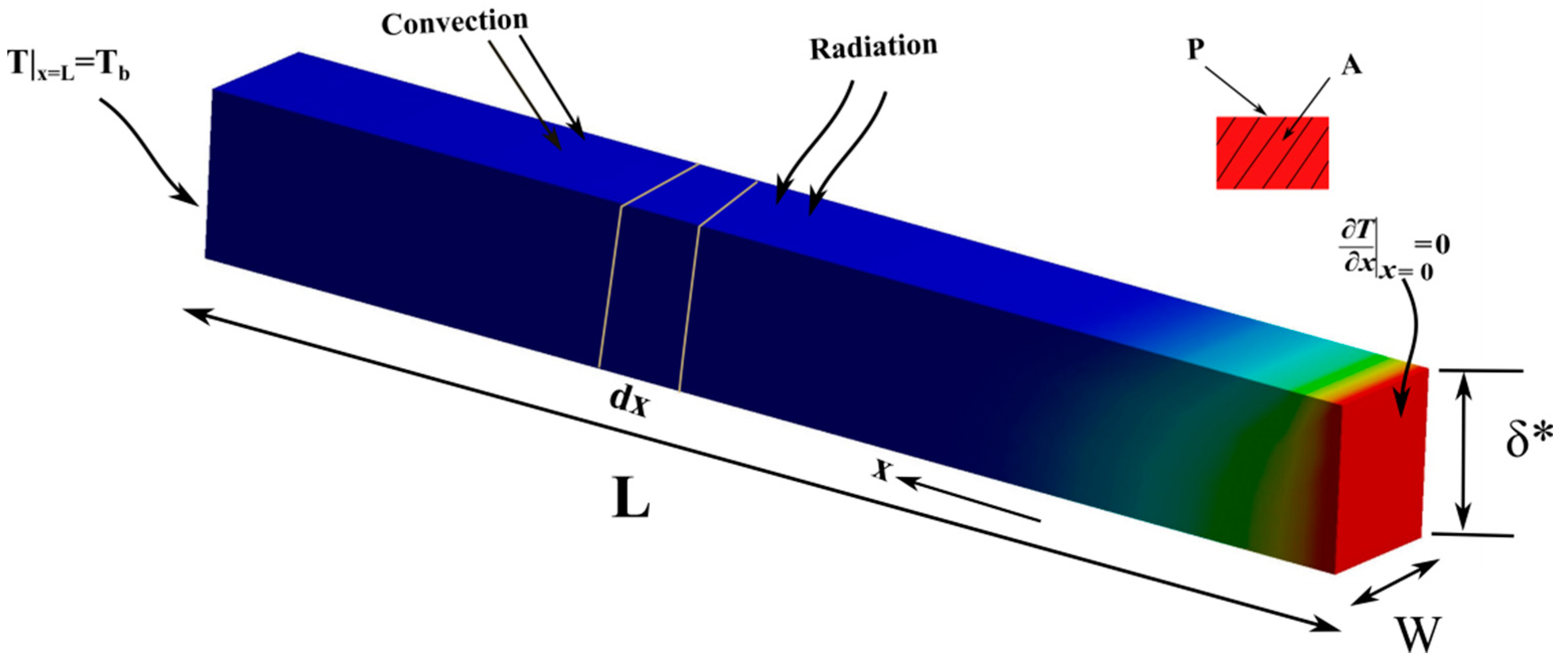
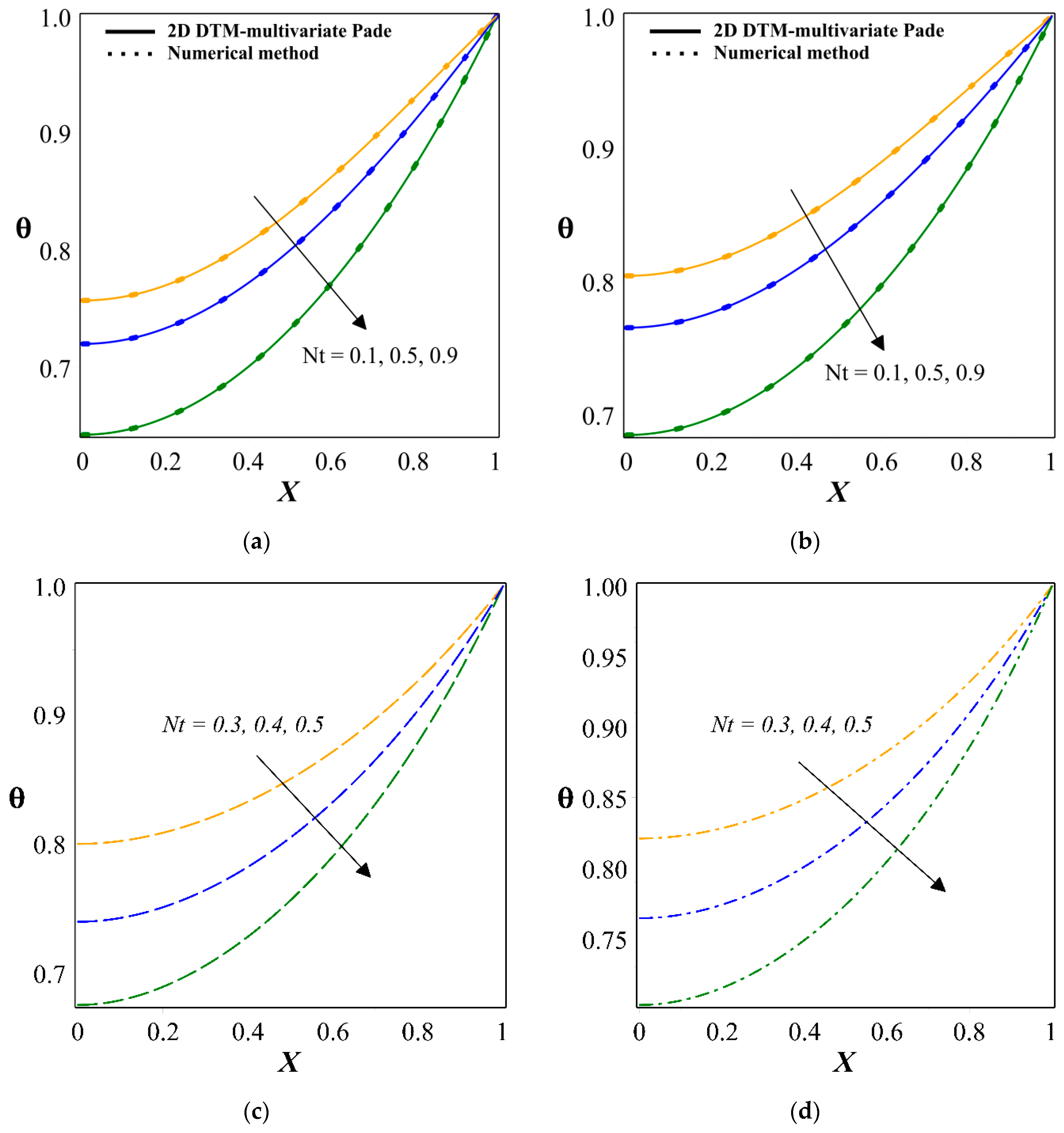



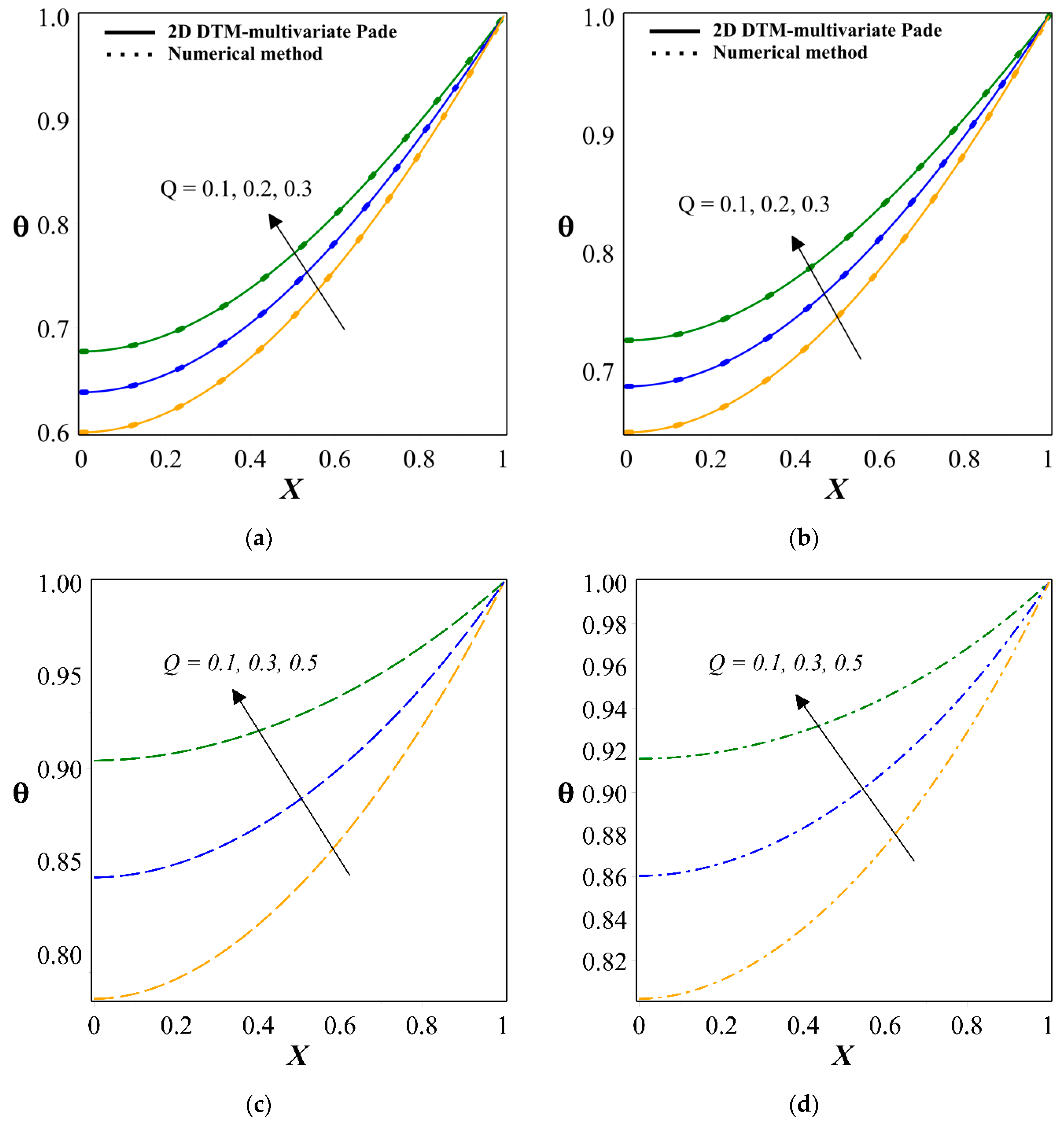



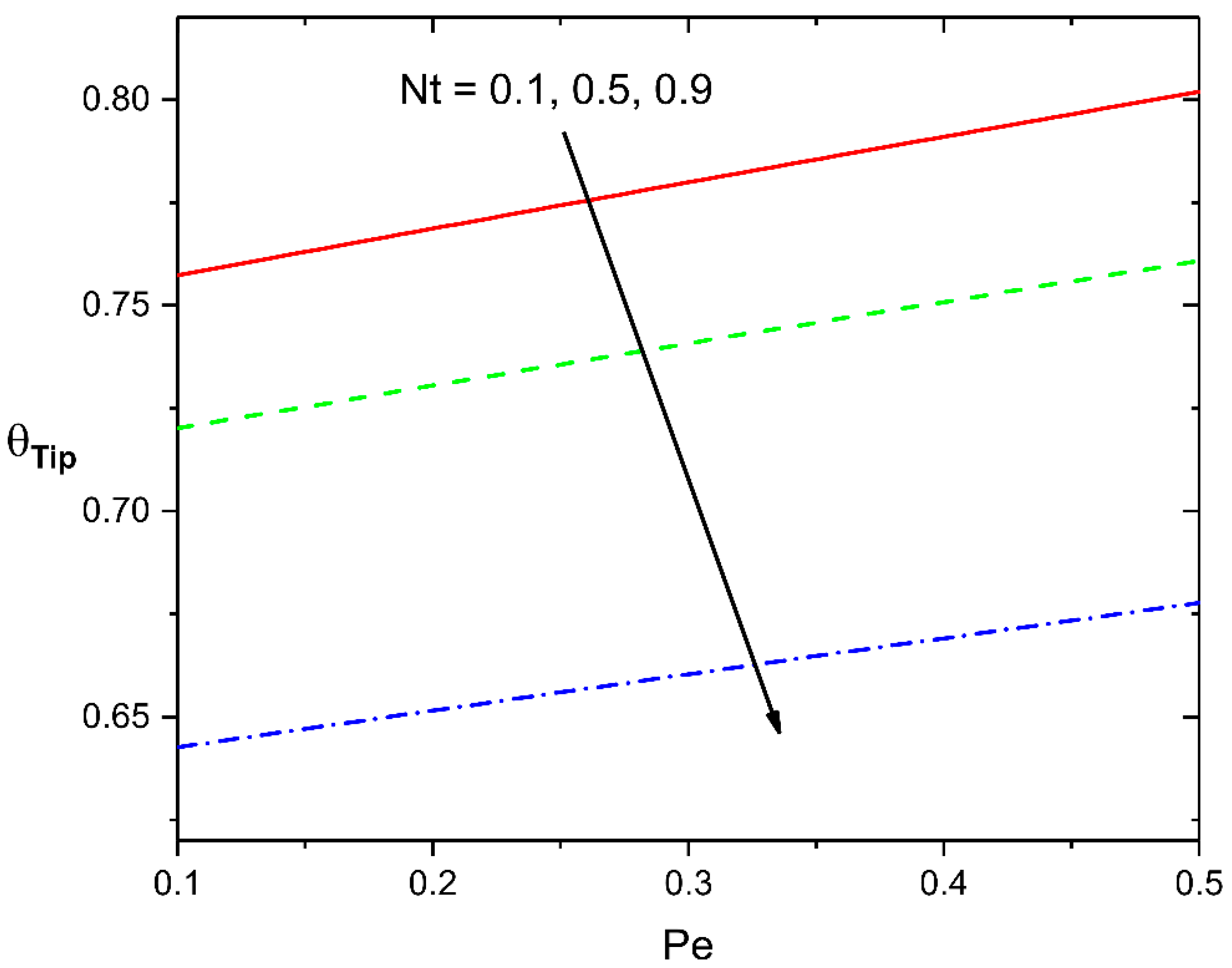

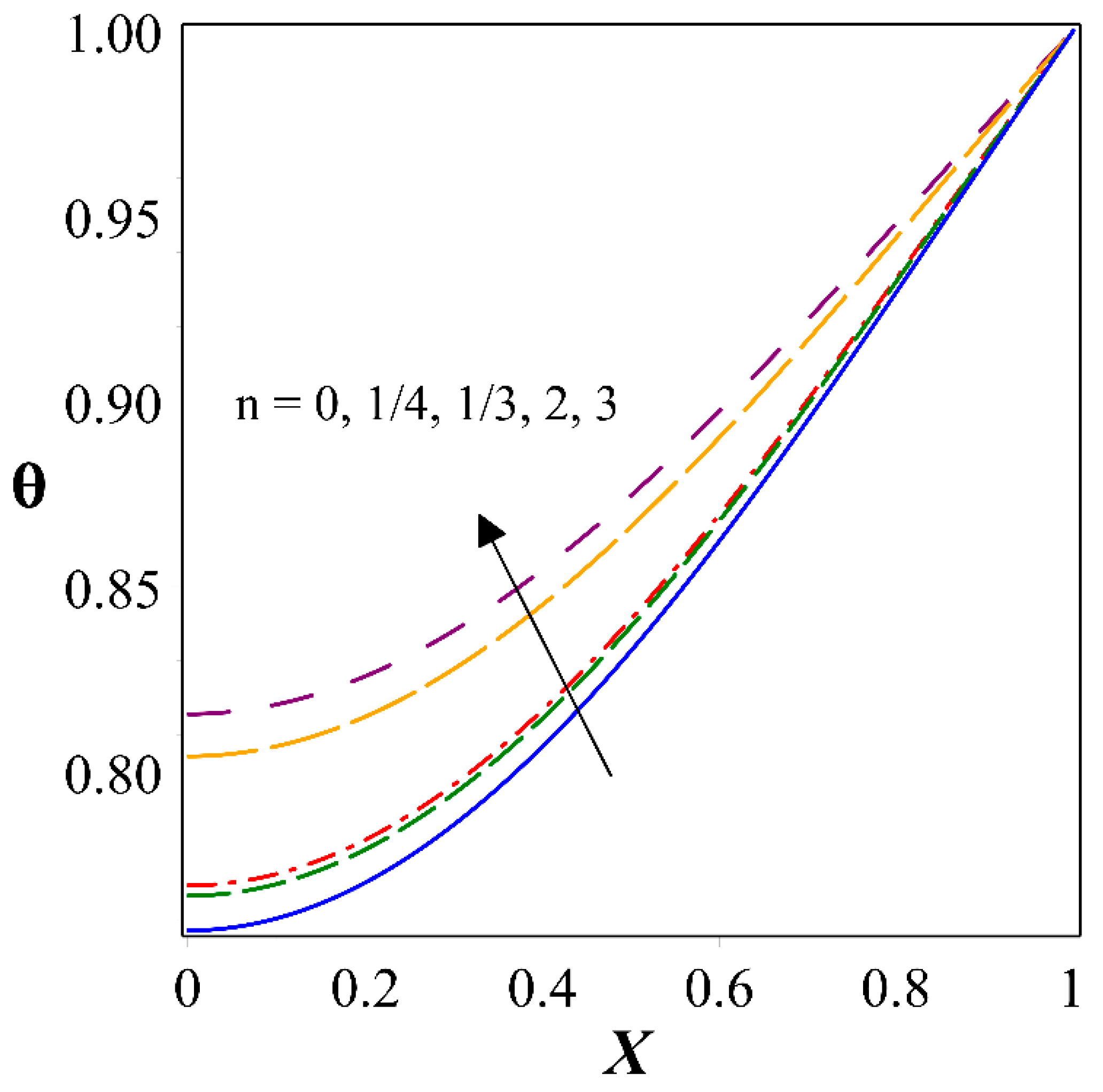
| Original Function | Transformed Function |
|---|---|
| , where are constants | |
| where and | |
Publisher’s Note: MDPI stays neutral with regard to jurisdictional claims in published maps and institutional affiliations. |
© 2021 by the authors. Licensee MDPI, Basel, Switzerland. This article is an open access article distributed under the terms and conditions of the Creative Commons Attribution (CC BY) license (https://creativecommons.org/licenses/by/4.0/).
Share and Cite
Sowmya, G.; Sarris, I.E.; Vishalakshi, C.S.; Kumar, R.S.V.; Prasannakumara, B.C. Analysis of Transient Thermal Distribution in a Convective–Radiative Moving Rod Using Two-Dimensional Differential Transform Method with Multivariate Pade Approximant. Symmetry 2021, 13, 1793. https://doi.org/10.3390/sym13101793
Sowmya G, Sarris IE, Vishalakshi CS, Kumar RSV, Prasannakumara BC. Analysis of Transient Thermal Distribution in a Convective–Radiative Moving Rod Using Two-Dimensional Differential Transform Method with Multivariate Pade Approximant. Symmetry. 2021; 13(10):1793. https://doi.org/10.3390/sym13101793
Chicago/Turabian StyleSowmya, Ganeshappa, Ioannis E. Sarris, Chandra Sen Vishalakshi, Ravikumar Shashikala Varun Kumar, and Ballajja Chandrappa Prasannakumara. 2021. "Analysis of Transient Thermal Distribution in a Convective–Radiative Moving Rod Using Two-Dimensional Differential Transform Method with Multivariate Pade Approximant" Symmetry 13, no. 10: 1793. https://doi.org/10.3390/sym13101793







